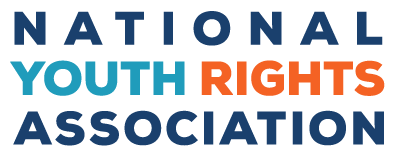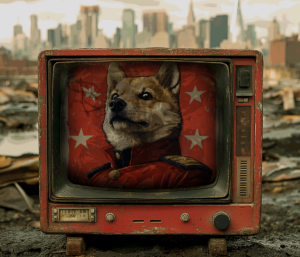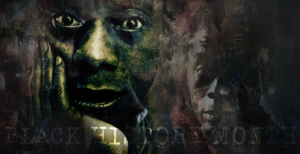Throughout history dominant majorities have redirected public attention away from the majorities’ problems and onto an artificially created scapegoat. Many countries have used a variety of scapegoats throughout time; this practice leads to persecution and anger towards the selected minority. Today in North American society a new scapegoat is being fabricated, this scapegoat is our youth. Due to powerful advocacy and protection organizations, scapegoating of other minorities is on the decline and the one remaining minority with no voice or say in society is our nation’s youth. A highly visible manifestation of this scapegoating is evident in society’s treatment of youth violence. By exaggerating the extent of youth violence, the media and politicians seek to promote their own personal agendas at the expense of the generation under the age of majority. Currently the public is being fed the idea of a plague of youth violence in society that will only get worse. The often proclaimed “epidemic of youth violence” is used by media, doctors and politicians to increase their ratings and profile in the nation.
In today’s society forms of mass media such as newspapers, television, and radio exert tremendous influence over the nation. Mass media streams into the homes of millions of people everyday. This broad audience gives the media the tremendous ability to shape the discussion around certain issues. Within a political framework the media is referred to as “the great mentioner” due to its ability to feature or ignore politicians’ campaigns and political issues. Through the years journalism integrity codes of impartiality have helped to ensure that this power would not be misused, but these safeguards are crumbling. In a competitive market news media must compete for an audience just like any other form of entertainment. The search for ratings leads media to sensationalize news and put slants on news that will sell advertisements and increase circulation. “The media pump fear in two ways. Because it’s a business and needs to attract attention, it goes for what’s shocking,” says Naneen Karraker, a Bay Area criminologist. “And by trying to get something zingy in a small space, the media simplify something that’s complex and often distort the facts.” (Farr, Fear Reigns) According to Newskit: A Consumers Guide to News Media, there are eight journalistic techniques that bias news reporting. These include: bias through selection and omission; bias through placement; bias by headline; bias by photos, captions and camera angles; bias through use of names and titles; bias through statistics and crowd counts; bias by source control; and through word choice and tone (Media-Awareness Network).
Just like in its role as “the great mentioner” media can affect stories through selection and omission, this is a dangerous tactic that is used very effectively in the negative portrayal of youth as violent predators. “A 1996 report by the Berkeley Media Studies Group found that more than half of local news stories on youth involved violence, and more than two-thirds of the violence stories concerned young people under age 25 (American Journal of Public Health, 8/97)…Eighty percent is committed by adults over 18” (Templeton). Clearly, the press is taking full advantage of their power to omit and is harming youth in the process.
The second technique involves the placement of stories in a newspaper or on a television broadcast. Stories on the front page or early in the show receive the most attention and the most emphasis. In the Thursday March 2, 2000 edition of the Washington Post, it was decided to place a shooting by a six-year-old gunman in which one person died on the front page, while placing a much more deadly shooting involving a 39-year-old man later in the paper. Although the shooting in a Pennsylvania McDonalds resulted in the death of 2 people and critically injuring 3 others it was not deemed as important as the less serious crime committed by a youth (Slevin and Sanderson A2; Claiborne A1).
The wording of headlines chosen is another common way to create bias in media; headlines are the most read element of a newspaper (Media Awareness Network), so by slanting them newspapers can affect the impressions of even more people. The headline on the front page of the March 1 Washington Post was “1st-Grader Shoots Classmate to Death” (Slevin and Claiborne A1). While the next day’s headline regarding the Pennsylvania shooting simply read, “Pa. Hostage-Taker Surrenders After Fatal Shootings” the headline describing the adult shooting is much less dramatic and not as inflammatory as the youth shooting headline (Slevin and Sanderson A2).
Also, different imagery included in the articles is a source of bias. Certain photo angles and pictures can capture different messages about the subject in them. Another source of media bias can be found in the way that mass media uses names and titles to describe the persons involved in crime. A paper could describe someone as an “ex-con” or as someone who “served time for a minor offense” while these statements could describe the same person, they clearly give a different slant to the reporting. (Media Awareness Network) The inflation of statistics and other numerical data is common practice among the press. Many people put more faith in statistics because they believe that they are harder to twist. For that reason they are more easily tricked when those statistics turn out to be biased.
Source control is a method used to misrepresent quotes and other facts in a news story. Using quotes from less reputable sources alongside professionals is an example of this. A hasty reader would fail to realize the bias in presenting conflicting views by two unequal speakers. Word choice and tone is one very effective method of creating a bias; minute differences in the meanings of words can convey subtle biases in the text of articles.
The biases listed here are all applied to the anti-youth hysteria that dominates mass media sources. While fundamentally no different than adult crime, youth crime results in disastrous stereotyping and scapegoating of our younger generation. The stereotyping of youth as violent predatory criminals is felt in the everyday lives of youth in this country and others. “Media spokespersons have uncorked their own fury at adolescents, revealing that anti-youth media distortions may not stem from poor journalism alone, but a large dose of personal hostility” (Males, Scapegoat Generation 27).
Most indicative of this youth scapegoating and labeling is the theory of the oncoming “super-predator” described by John DiIulio, a professor of politics and public affairs at Princeton University, in a 1995 article in the conservative Weekly Standard magazine. Based on demographic information that predicts a surge in the youth population around the year 2010, DiIulio concludes that a new breed of “high-rate juvenile offenders [will be] coming at us in waves over the next several decades” (Farr, Getting Tough). Based on the conclusion that the number of criminals within a demographic group is a constant percentage, DiIulio argues that a projected increase in youth population will create a dramatic increase in the number of juvenile offenders. However, Franklin E. Zimring a professor of law at the University of California at Berkley, states that “the only proper inference to be drawn from knowing that an extra million teenagers will be present at some future time is that there will be a larger group of teenagers” (Zimring 63).
The media has used this over-hyped concept of “super-predators” extensively to induce fear in the populous. “TV news has been guilty of fanning the flames of fear” says Larry Perret, news director for KCBS-TV (channel 2) in Los Angeles (qtd. in Farr, Fear Reigns). The media has been highly successful in “fanning the flames of fear” and have created a massive public misconception about youth crime. In a recent Gallup poll adults were asked about youth crime rates, “The adults polled estimated that youth were responsible for 43 percent of violent crimes. The truth? FBI statistics show that juveniles are responsible for 13 percent of violent crime, less than a third of what the adults polled thought” (Bervera, Cyril and Yarborough). A direct result of this national misconception of youth is the recent trend in cracking down upon youth crime. Currently youth sentences are “60 percent longer than adult sentences for the same crime” (Bervera, Cyril and Yarborough). Certainly this media induced fear is guilty of propagating the image of youth being violent predatory criminals, and is eliciting heavy-handed and harmful responses against youth across the nation.
One such victim of this “anti-youth hysteria” is current American University freshman, Carrie Rainen. In high school Carrie and her friends were labeled as different by the rest of the school. After the Columbine tragedy Carrie and her friends came into conflict with the authorities.
“Ryan was probably the sweetest kid on earth, who would lay down his life for any of his friends. He was a shy, quiet boy, who often retreated into his artwork, music, or video games. He and his best friend, Matt were also black clad, free thinkers. As the year went by, Ryan and Matt adopted a very gothic style. They wore long black trench coats and spike bracelets. Ryan also had an incredibly big spike necklace and he let his long hair grow out, shaved underneath and dyed it bright red. Though on the outside, Ryan looked weird, he was still a sweetheart. His style was just his way of expressing his artistic talent and interests. After Columbine, however, the school cracked down on us “weirdos”–I had to stop wearing my biker jacket and my bike chain bracelet; Eric had to leave his spikes at home. But no one was more affected than Matt, and especially Ryan. At one point, one of the assistant principals yanked his necklace off. Guidance all of a sudden took an interest in them. Their parents were called. And they were not allowed to wear their trench coats to school anymore. This upset me a lot, because no one ever took the time to talk to us. They saw that we were different, and by sad coincidence, shared some interests with the Columbine killers. That was no reason to all of a sudden take away our rights of self-expression…had my school even had a hint of a dress code, maybe then I would understand, but nothing was forbidden to wear at my high school…after Columbine, the killers were held up as models for the insane outcast killer.”
Clearly, measures taken in response to the media’s creation of anti-youth fear have had a disastrous effect on innocent youth across the nation. The fear that is being created towards youth can be compared to the red scare of the nineteen-fifties. Yet the stories of the innocent youth who lose their freedoms from restrictive new rules never make the headlines.
Media bias is the first step; once they have made the agenda, the politicians respond to their constituents’ misinformed beliefs. Constituents get their fear from the “6 o’clock news — it’s all crime reporting,” says Robert Presley, former California state senator and now chairman of the Sacramento-based Youthful Offender Parole Board. “The public fears violent crime. And the Legislature and Congress respond to the public fears” (Farr, Fear Reigns). From local school boards to state governments to the President himself, all officials feel the need to appear to be solving the “youth problem,” though often their programs have little effect in solving the real problems. In pursuit of re-election, politicians create programs that affect youth. Therefore, they are tackling a problem that concerns all of society, but only negatively affecting non-voters.
Recently President Clinton wrote a report titled, “The President’s Anti-Gang and Youth Violence Strategy” this report contains much anti-youth bias and stereotypes. The first paragraph of the overview to this report states, “While overall crime rates are dropping, young people are increasingly the perpetrators and victims of some of society’s most violent crimes. Indeed, until recently, the rate of youth violence has climbed dramatically. For example, between 1984 and 1993, the rate of homicides committed by juveniles skyrocketed 169%”(Clinton). This report was written in 1997, after four years of declining youth crime. Yet Clinton uses older statistics to fabricate a need for his new programs. Clinton’s methods are indicative of what politicians in all areas and from both parties do to use the public’s focus on youth crime to make themselves appear to be helping the problem.
Clinton highlights policy initiatives such as curfews, school uniforms, and drug testing as positive actions that should be implemented to solve the youth violence problem. These programs take away constitutionally protected liberties from youth. However, since youth do not vote they cannot object. These false solutions appear beneficial to an adult voting age population who are unaffected by these policies, but in fact do little to solve the problem of youth violence. Mike A. Males a sociologist and author wrote a paper discussing the effectualness of youth curfews. In this report he says, “A major underlying assumption of curfews is that they reduce risk by removing juveniles from public space. However, there is no systematic study of the effects of curfew” (Males and Macallair, Analysis of Curfew). Males argues that media images of the effectiveness of youth curfews are based on scattered anecdotal evidence. “Claims to date that curfews affect crime and youth behavior represent little more than unsupported assertions” (Males and Macallair, Analysis of Curfew).
Curfew laws are unproven solutions to complex problems, yet they are seen as good public policy. Politicians are eager to support vote-getting initiatives like curfews and other laws purported to solve youth violence. A knowledgeable Senate source said in 1984 that a separate anti-youth issue “is now seen as good public policy, one you can’t lose on, and this is an election year” (Feaver). This type of thinking permeates our body of elected officials.
Politicians and the media frequently make use of scientific studies and doctor’s research regarding the physical and emotional state of adolescents. Labeling youth as a class of people full of “storm and stress” contributes to the notion that they cannot become full members of our society and deserve special behavioral restrictions unheard of in the adult world. Modern perceptions of unstable youth harken back to the age of “genetic determinism” a pseudo-science prominent at the turn of the 20th century. These scientists conducted highly bigoted and biased studies meant to prove that non-white races and women were genetically inferior to white males and therefore required less rights and privileges. “The respected American Medicine of 1907 editorialized against expanding rights for blacks who, being “without brains,” could not comprehend the implications of their actions” (Males, Scapegoat Generation 32). This form of racist science formed the basis of southern arguments in favor of white supremacy.
Today these racist theories have been wholly discarded, and their error and bigotry have been realized. Unfortunately, new bigotry has arisen towards the new scapegoat in society- adolescents. The New Physician reported the following on teen suicide: “Adolescence is a time of turbulence marked by rapid, physical, sexual, social and emotional development. It is a time of confusion and rebellion” (qtd. in Males Scapegoat Generation 33). If women or non-whites were referred to as “confused or rebellious” the author of the article would be shunned from the medical community. Yet, society is inundated with studies and comments such as these and use them to form public policy.
While youth violence is a terrible problem in our nation, current efforts to combat it based on stereotyping and scapegoating of youth as “predatory animals” have proven to cause more harm than good. Powerful national forces such as the media, politicians and the medical community perpetuate the idea of youth as an inferior class of people responsible for societies ills and deserving of harsh penalties. This negative view has had a disastrous effect on youth, and the situation is only getting worse. Everyday, more restrictive laws are passed, and more biased stories hit the airwaves. Adult crime and violence is proportionally ignored compared to youth violence. Yet, adult violence is much more of a problem than violence committed by youth. In spite of dangerous levels of adult violence, youth are the scapegoat which society has chosen to bear the burden of blame.
Sources
- Bervera, Sarah, Malkia Cyril and Ortega Yarborough. “When Perceptions Are Not Reality: Youth role in crime exaggerated.” The San Francisco Chronicle. 9 October 1998.
- Claiborne, William. “A ‘Life in Chaos’ Shaped Young Shooter.” The Washington Post. 2 March 2000.: A1.
- Clinton, William J. “The President’s Anti-Gang and Youth Violence Strategy — An Overview” 18 February 2000.
- Farr, Jory. “Fear Reigns”. A State Behind Bars: California’s Prison Boom. 27 March 2000.
- Farr, Jory. “Getting Tough on Youthful Offenders”. A State Behind Bars: California’s Prison Boom. 27 March 2000. < http://www.press-enterprise.com/focus/prison/html/getting_tough.html>.
- Feaver, Douglas B. “House Bill Ties Highway Aid, Drinking Age.” The Washington Post, 8 June 1984.
- Males, Mike and Dan Macallair. “An Analysis of Curfew Enforcement and Juvenile Crime in California.” Western Criminology Review 1.
- Males, Mike A. The Scapegoat Generation: America’s War on Adolescents. Monroe, Maine: Common Courage Press, 1996
- Media Awareness Network. “Detecting Bias in the News”. 6 March 2000.
- Rainen, Carrie. Personal Online Interview. 30 March 2000.
- Slevin, Peter and Jaclyn Sanderson. “Pa. Hostage-Taker Surrenders after Fatal Shootings.” The Washington Post. 2 March 2000.: A2.
- Slevin, Peter and William Claiborne. “1st-Grader Shoots Classmate to Death.” The Washington Post. 1 March 2000.: A1.
- Templeton, Robin. “Superscapegoating.” Media Awareness Network. 29 March 2000. < http://www.media-awareness.ca/eng/med/comm/youth/toolkit/scape.htm>.
- Zimring, Franklin E. American Youth Violence. New York: Oxford University Press, 1998





